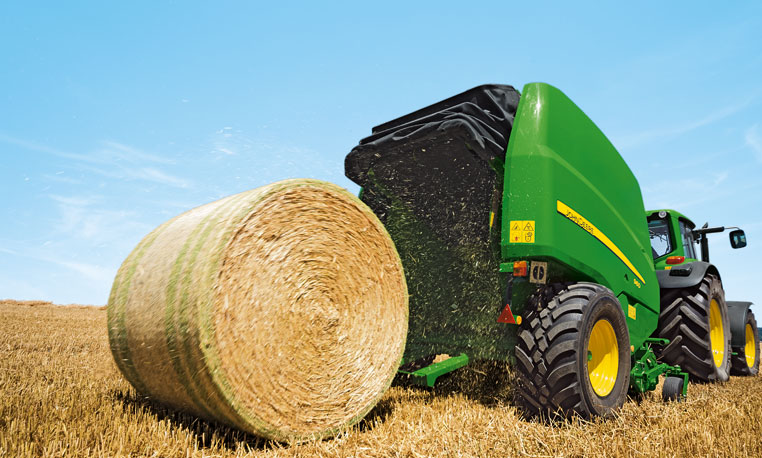Agriculture
Baler Machine
- 13 Nov 2023
- 5 min read
For Prelims: Baler Machine, Stubble Management, Crop Residue Management (CRM) Scheme, Farm Fires, Belar Machine, Stubble Burning Alternatives, In-situ Stubble Treatment, Bio-decomposers, Turbo Happy Seeder (THS), Balers in Agriculture, Air Pollution, Soil Degradation.
For Mains: Technology in the Aid of Farmers, Indigenisation of Technology for Agriculture, Issue is Stubble Management
Why in News?
With the problem of farm fires being taken up by the Supreme Court, Belar, a machine that facilitates ex-situ (off-site) stubble management has been in demand in Punjab and adjacent regions.
Baler machines have been around for a decade, and currently around 2,000 of them operate in Punjab. Of these 1,268 are highly subsidised (50-80%) under the Centre’s Crop Residue Management (CRM) scheme.
What is the Crop Residue Management (CRM) Scheme?
- About:
- It is a Central Sector Scheme launched under the Ministry of Agriculture & Farmers Welfare to address the issue of stubble burning by assisting farmers and related organisations.
- Financial Assistance under the Scheme:
- Farmers receive financial assistance at a rate of 50% for the purchase of crop residue management machinery.
- Cooperative Societies, Farmer Producer Organizations (FPOs), and Panchayats receive financial assistance at a rate of 80% for establishing Custom Hiring Centres (CHCs).
- Scheme Supported Machines:
- Super Straw Management Systems, Happy Seeder, Super Seeder, Smart Seeder, zero till seed cum fertilizer drill, Mulcher, Paddy Straw Chopper, hydraulically reversible mould board plough, Crop reapers, Reaper binders, Balers, and Rakes.
What is a Baler Machine?
- About:
- Balers play a pivotal role in stubble compression, acting as hydraulic presses to compact crop residues into dense, manageable packages. These compressed stubbles are securely bound using twine, wire, or strapping.
- Before using a baler machine, farmers cut the crop residue with a tractor-mounted cutter. A tractor-mounted baler machine compresses the stubble into compact bales using netting.
- Balers play a pivotal role in stubble compression, acting as hydraulic presses to compact crop residues into dense, manageable packages. These compressed stubbles are securely bound using twine, wire, or strapping.
- Significance:
- Environmental Preservation: Eliminates the need for crop stubble burning, contributing to reduced air pollution and soil degradation.
- Farmers burn stubble after harvesting, which contributes to air pollution. Balers offer an environmentally-friendly alternative to burning stubble by compressing it into bales.
- Resource Efficiency: Efficiently compresses stubble, making it easier for handling, transport, and storage.
- It allows farmers to immediately plough the field and sow the next crop.
- Economic Gain: Opens avenues for revenue generation through the sale of compressed stubble as a valuable resource.
- Environmental Preservation: Eliminates the need for crop stubble burning, contributing to reduced air pollution and soil degradation.
- Other Ways to Handle Stubble:
- In-situ treatment of Stubble: For example, crop residue management by zero-tiller machine and Use of bio-decomposers (e.g., Pusa bio-decomposer).
- Use of Technology: For example, Turbo Happy Seeder (THS) machine, which can uproot the stubble and also sow seeds in the area cleared. The stubble can then be used as mulch for the field.
What are the Issues with Balers?
- High Input Cost: A single baler costs about Rs 14.5 lakh without subsidies. Currently, there are around 700 non-subsidized balers operating in Punjab.
- Affordability Issue: No baler units were sold in the first two years after being included under the Crop Residue Management scheme.
- Unavailability of Enough Machines: Punjab has around 32 lakh hectares of rice fields, but only 15-18% of this area can be covered by the available balers in the state. One baler can cover only 15-20 acres in a day.
What is Stubble Burning?
- Stubble (parali) burning is a method of removing paddy crop residues from the field to sow wheat from the last week of September to November, coinciding with the withdrawal of the southwest monsoon.
- Stubble burning is a process of setting on fire the straw stubble, left after the harvesting of grains, like paddy, wheat, etc. It is usually required in areas that use the combined harvesting method which leaves crop residue behind.





